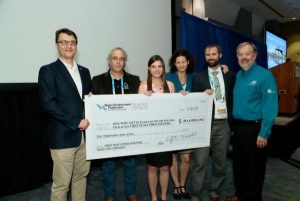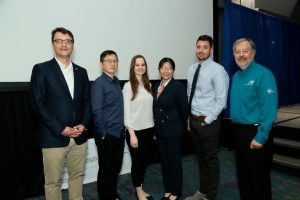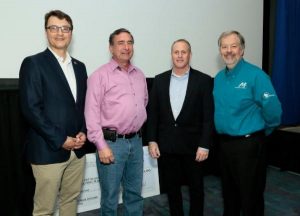At WEFTEC 2019, the Water Environment Federation (WEF; Alexandria, Va.) and the Water Research Foundation (Denver, Colo.) recognized three U.S. utilities for projects that demonstrate technology’s potential to solve complex environmental and economic challenges.
This year’s winners of the Leaders Innovation Forum for Technology (LIFT) Intelligent Water Systems Challenge were the City of Boulder, Colo., in first place; the Metropolitan Water Reclamation District of Greater Chicago (MWRD) in second place; and Pima County, Ariz., in third place.
“The Intelligent Water Systems Challenge provides a unique showcase for water sector innovation and collaboration,” said WEF Executive Director Walt Marlowe. “This year’s challenge was an impressive show of knowledge and talent, and we are proud to support this effort to help foster the adoption of smart water technologies.”
1st Place: City of Boulder, Colo., Examines Ammonia-Based Aeration
Biological nutrient removal (BNR) processes such as activated sludge have become an industry mainstay to help utilities meet increasingly stringent regulatory requirements. However, conventional aeration processes in BNR facilities often fail to adapt to real-time process conditions, leading to large and rapid fluctuations in air demands and dissolved oxygen contents in activated sludge that stress aeration blowers and undermine the BNR process.

The winning team from Boulder, Colo., the Colorado School of Mines (Golden), Baylor University (Waco, Texas), and Carollo Engineers (Walnut Creek, Calif.) included Christopher Marks; Tzahi Cath; Mandy Hering; Kathryn Newhart; and Tanya Rauch-Williams. Photo courtesy of Water Environment Federation (Alexandria, Va.)/Water Research Foundation (Denver, Colo.).
One way that technology can improve the BNR process, found the team from Boulder, is by reprogramming supervisory control and data acquisition (SCADA) systems with a type of logic called ammonia-based aeration control (ABAC). ABAC logic uses simple information from operators — such as the desired amount of ammonia in influent to spur efficient nutrient removal and acceptable ranges of dissolved oxygen contents — as a guide. The process then constantly monitors process conditions and changes its operating parameters as needed to keep the aeration process as stable as possible during the BNR stage.
The team, made up of Boulder water utility staff and partners from Carollo Engineers (Walnut Creek, Calif.), the Colorado School of Mines (Golden), and Baylor University (Waco, Texas), described in its submission documents how ABAC has been available for years, but adoption has lagged as many utilities lack data on whether the logic is more effective than conventional options.
The team’s winning project, titled “Predictive Modelling and Performance Assessment of Ammonia-Based Aeriation Control,” fills the data gap by detailing results of an extensive testing campaign.
Read the Boulder team’s full submission to learn more about how implementing an ABAC scheme can lead to a more stable BNR aeration process, save energy, and prolong the life of water resource recovery facility infrastructure.
2nd Place: Chicago Uses Technology to Balance Chemicals
Until 2015, operators at the James C. Kirie Water Reclamation Plant in Des Plaines, Ill., routinely added sodium hypochlorite into influent at the facility’s headworks to discourage the formation of hydrogen sulfide, a product of the wastewater treatment process linked to odor complaints and infrastructure corrosion. But when the facility implemented a new enhanced biological phosphorus removal program, managers suspended sodium hypochlorite dosing due to concerns that adding the chemical could reduce volatile fatty acid (VFA) content in influent and undermine the biological phosphorus removal process.

Awarded second place, the team from the Metropolitan Water Reclamation District of Greater Chicago and Illinois State University (Normal) included Fenghua Yang; Xing Fang; Kyle Francq; Matthew Jurjovec; Thais Pluth; and Yongning Tang. Photo courtesy of Water Environment Federation (Alexandria, Va.)/Water Research Foundation (Denver, Colo.).
When sodium hypochlorite dosing stopped, facility infrastructure began to corrode at an alarming rate. MWRD, who operates the Kirie facility, began exploring technology that could help operators strike an optimal balance between concentrations of sodium hypochlorite, hydrogen sulfide, and VFAs in influent that could keep the nutrient removal process running efficiently without exacerbating odor and corrosion risks.
Similar to the Boulder team, MWRD turned to its SCADA system for a solution. The utility partnered with researchers from Illinois State University (Normal) to develop a machine-learning algorithm that uses influent composition and quality parameters alongside daily rainfall data and historic relationships between sodium hypochlorite dosage amounts and hydrogen sulfide production levels to recommend optimal dosages.
Trialed on different amounts of sodium hypochlorite, the team’s models were able to predict hydrogen sulfide and VFA levels with over 90% accuracy during pilot tests, according to the MWRD submission. Calculations by the team find that if the model had been implemented between 2010 and 2014, the utility could have saved nearly $25,000 per year on chemical costs.
The team developed its models entirely in the open-source Python language, meaning that any utility can adopt the model so long as it has access to sufficient data. Read the MWRD team’s full submission for details.
3rd Place: Pima County, Ariz., Drastically Cuts Energy Use
Meeting electrical energy demands can often be the single largest regular expenditure for most water utilities. In 2018, the U.S. Environmental Protection Agency estimated that U.S. water utilities use more than 56 billion kW of electricity per year, with a combined cost topping $4 billion.
The team from the Pima County Regional Wastewater Reclamation Department set out to create a comprehensive plan for reducing energy use by 15% at the 50-mgd Tres Rios Water Reclamation Facility (Tucson, Ariz.).

All employees of the Pima County Regional Wastewater Reclamation Department, Jeff Prevatt; Allan Anthon; Barry Holbert; Timothy Mason; Dean Moulis; and Larry Sawicki won third place in the 2019 LIFT Intelligent Water Systems Challenge. Photo courtesy of Water Environment Federation (Alexandria, Va.)/Water Research Foundation (Denver, Colo.).
The first stages of the plan involved gauging the facility’s current energy use. Facility staff determined that Tres Rios uses about 94 MWh of electricity per day, with nearly half of that usage supporting aeration and system cooling. From there, the team examined different approaches to minimize energy use, for example by converting lighting fixtures, motors, and drives to more efficient alternatives and re-evaluating operating conditions.
By using a single, larger blower rather than two smaller ones for Tres Rios’ two aeration basins during low-flow conditions, the utility found it could save more than $100,000 per year. By reconfiguring the facility’s screw pumps to operate according to real-time conditions rather than on a predetermined schedule, the pumps ran for about 5 fewer hours per day, resulting in nearly $30,000 per year in savings. Facility staff also invested $784,000 in an automated power factor correction capacitor bank at the utility’s electrical distribution center, eliminating nearly $100,000 per year in penalties from the electrical provider.
With these and other improvements, the utility succeeded in cutting total facility energy use by 13.9%, saving about $385,000 per year. The effort also led to a standardized, user-friendly process for addressing high energy costs that Pima County plans to apply to its other facilities.
Read the Pima County team’s full submission for ideas on how to minimize power consumption and provide greater financial flexibility for utility programs and upgrades.
Interested in participating in the 2020 LIFT Intelligent Water Systems Challenge? Register your team by March 20, 2020.
─ Justin Jacques, WEF Highlights








December 17, 2019
Featured, WEF Resources & Efforts